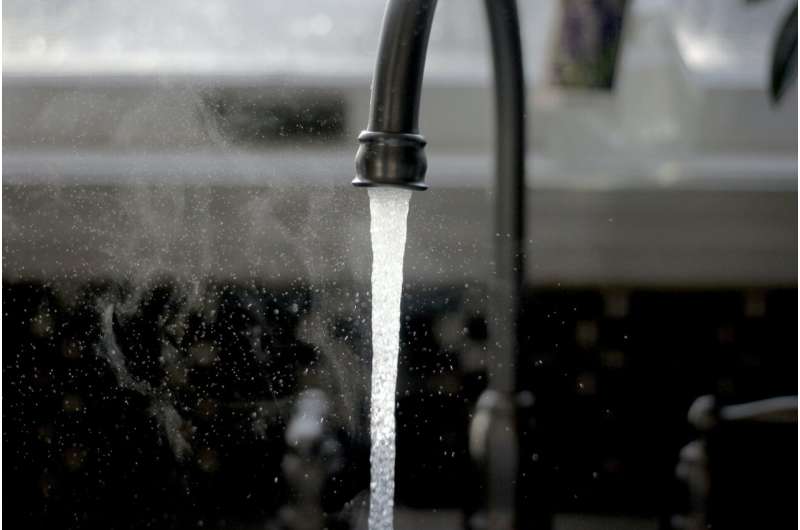Fresh-water scarcity prompts hunt for more from the air and sea

As supplies of fresh water shrink around the world, efforts are under way to extract more of it from the air and sea. European research projects and companies are at the forefront of this technological challenge.
Carlos Garcia foresees a world in which many millions of homes will get water out of thin air—literally.
Garcia is general manager of GENAQ, a Spanish company that makes devices known as atmospheric water generators. By condensing humidity in the air into usable water, such generators can help create much-needed supplies.
Supply crunch
Water, the source of life, is becoming increasingly scarce as the world's population grows and climate change intensifies.
"This is a problem we really need to tackle," said Garcia, whose company led the STRATUS project to expand the market for atmospheric water generators.
According to the United Nations, 2.3 billion people—more than one in four—live in a "water-stressed" country, which is defined as one that removes at least 25% of its fresh water every year to meet demand. And 4 billion people face severe water scarcity for at least one month a year.
In Europe, where global warming is already causing more frequent and severe droughts, scientists and businesses are developing new methods to generate fresh water from the air as well as the sea. The push is also driven by pollutants in underground water and the environmental cost of bottled water.
While GENAQ has been developing atmospheric water generators since 2008 and has customers in 60 countries, so far it has served mainly emergency services and industrial users.
Home use
Through STRATUS, the company developed a version designed for people at home. These new generators can be attached to houses and create fresh water for their inhabitants.
GENAQ wants to sell three versions of the product, ranging in amount from 20 liters a day to 200 liters and in size from a small kitchen appliance to a version that looks like an office water cooler. Anticipated prices range from €2 500 for the smallest version to €14 500 for the biggest.
"The device takes air and filters it, ensuring there are no contaminants going into the condensation chamber," said Garcia.
First air is cooled to a point where water condenses. Then the water is filtered, minerals are added and it gets zapped with ultraviolet light to prevent bacteria forming.
GENAQ found a way to cut drastically the amount of energy used in the process—150% less—and the average cost of portable water fell by more than 80%.
"We have dedicated most of our efforts to efficiency," said Garcia.
But atmospheric water generators depend on something beyond GENAQ's control: weather.
"The best performance is in hot and humid climates," said Garcia. "Cold and dry environments don't perform very well, but indoor conditions of houses are well suited for this solution."
GENAQ is now aiming to supply everyday families with atmospheric water generators.
In the coming months, it plans to expand in European countries such as Spain, France and Germany where bottled-water consumption is high. A subsequent step is to break into the worldwide consumer market.
Sea source
In Belgium, a company called HydroVolta is improving ways to take salty or brackish water and convert it into fresh water under the SonixED project.
The vast majority of the earth's water is saltwater. Only 3% is fresh water and less than one third of that is accessible, the rest being locked away in glaciers and groundwater.
"We will need to treat saline water so people can drink it and industry can use it," said George Brik, chief executive officer of HydroVolta. "But with the current technologies, desalination requires high investments and high operational costs. On top of that, existing technology uses high amounts of energy and chemicals."
Although desalination has taken place for years and usually features in countries with dry climates, increases in water scarcity are fuelling interest in the activity in other parts of the world including northern Europe.
The basic technique to turn saltwater into fresh water is electrodialysis, where ions are transported through membranes to separate the salt from the water.
But the method has a weak point: the membrane, which gets dirty easily and requires chemicals and high pressure to clean. That in turn involves large amounts of energy.
Under SonixED, HydroVolta developed ultrasound technology that keeps the membrane clean in a much more efficient way.
Less pressure, more water
Energy use in this field depends on pressure, which is measured in a metric unit known as bar. Existing technologies to desalinate seawater take around 50 to 80 bar, according to Brik, who said the new HydroVolta technology uses just one to three bar.
Even better is that a greater amount of fresh water can now be generated, he said.
"Existing technologies waste around 60 to 65% of the seawater that's taken in," said Brik. "Our new technology inverts that percentage. If we take in 100 liters of seawater, we can produce 65 liters of drinkable water."
HydroVolta wants to supply this technology to larger companies to generate drinkable water as well as to industrial players that need water to fuel their operations. The company is carrying out tests with several Belgian businesses to generate drinkable water from the North Sea.
Meanwhile, Brik says new desalination technologies may need a push from governments to spur broader demand.
"They can be the first customers," he said. "This will help companies show the world what they have and scale up."
















